Royal Poinciana (Flamboyant Tree): Flowers, Leaves (Pictures) – Identification
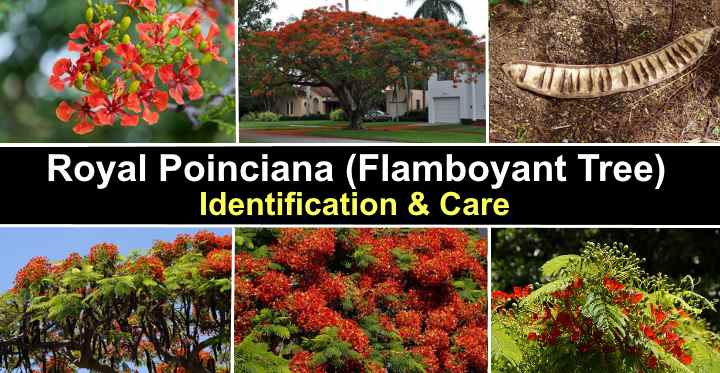
Royal poinciana is a stunning flowering evergreen tree that blooms with masses of showy red-orange flowers in late spring and early summer. Also called the flame of the forest, flamboyant tree, or flame tree, the royal poinciana is known for its fern-like leaves, spreading umbrella-like canopy, and attractive mahogany seed pods.
Royal poinciana trees are common throughout Florida, southern Texas, Central America, and the humid regions of Mexico. In a tropical climate, the ornamental flowering tree is relatively easy to grow and withstands dry conditions in coastal areas. You can also grow royal poinciana in containers to add color and beauty to a patio in more temperate climates.
This article is a complete guide to the spectacular royal poinciana tree. Descriptions and pictures of the flamboyant tree’s flowers, bi-pinnate leaves, bark, and seeds will help identify the decorative tropical tree. In addition, you’ll get helpful tips on growing a flame tree in your garden landscape.
Royal Poinciana (Delonix regia) Facts
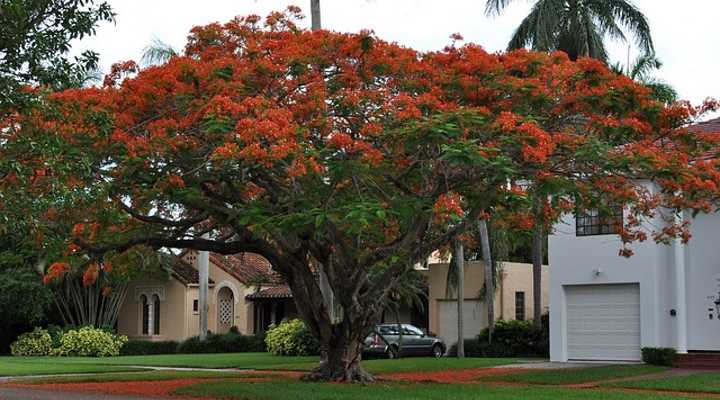
Royal poinciana (Delonix regia) is also called the flamboyant tree or flame tree
Royal poinciana is a stunning flowering tree in the genus Delonix and pea family Fabaceae. The flame tree grows 30 to 40 ft. (9 – 12 m) tall and 40 to 70 ft. (12 – 21 m) wide. As one of the most beautiful tropical trees, royal poinciana explodes into a profusion of brilliant red and orange hues in late spring.
Royal poinciana trees thrive in USDA zones 10 through 12. However, as a heat-loving and sunshine-loving tropical tree, this flamboyant specimen performs best in full sun and relatively dry conditions.
Due to its vast spread, the flame tree is an excellent blooming shade tree for hot, humid climates. The tree has a rounded, spreading canopy that is nearly twice as wide as it’s tall. In addition, the tree’s attractive feathery fern-like foliage provides dappled shade throughout the year.
The royal poinciana tree has a fast growth rate and increases in height about 5 ft. (1.5 m) per year. The evergreen flamboyant tree can live for over 50 years. Although the tree can grow well in partial shade, its growth rate will be slower. After planting, it can take a young royal poinciana tree 5 to 12 years to start flowering.
Although classified as a tropical evergreen tree, royal poinciana has deciduous foliage in areas with a mildly cool winter or dry season. During these times, the tree sheds its lacy, feathery, mimosa-like leaves.
Apart from being called the flamboyant tree or flame tree, other common names for Delonix regia include peacock flower tree, red tree, flame of the forest, and royal poinciana.
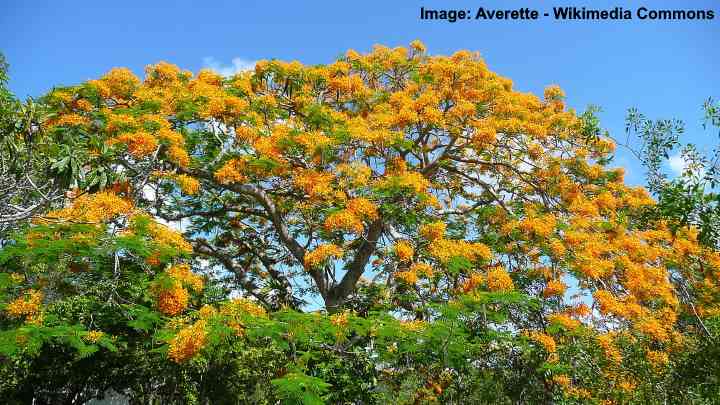
Golden royal poinciana / yellow poinciana (Delonix regia var. flavida) is rare cultivar of royal poinciana with yellow flowers
Royal poinciana trees tend to be relatively messy trees. The abundance of seed pods can create an enormous clean-up job in late fall. Also, the tiny leaves can clog up pool filters and drains when they fall during dry seasons.
It’s also good to note that royal poinciana has buttress roots that can become invasive. In addition, the tree’s roots tend to be relatively shallow and can damage driveways, sidewalks, lawns, or properties. Therefore, you shouldn’t plant royal poinciana too close to buildings due to the shallow root system and broad crown.
Royal Poinciana Flowers
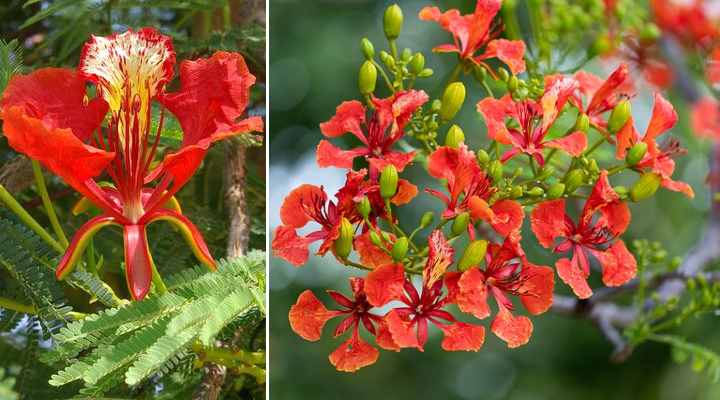
Royal poinciana flowers
The brilliantly-colored flowers growing on a royal poinciana tree are an orange-red or scarlet color. Each bloom consists of four clawed petals with a spoon shape, and there is an additional fifth petal with streaks of white and yellow. The large flowers grow in showy clusters and measure 3” to 4” (7.5 – 10 cm) across.
Royal poinciana blooms from late May to July. The clusters of reddish-orange orchid-like flowers bloom on the ends of branches. The flame tree looks like a vast, colorful umbrella in full bloom.
The botanical name of the royal poinciana tree — Delonix regia — alludes to its showy flowers. The Greek word delos means conspicuous or showy, and onyx means claw.
Royal Poinciana Leaves
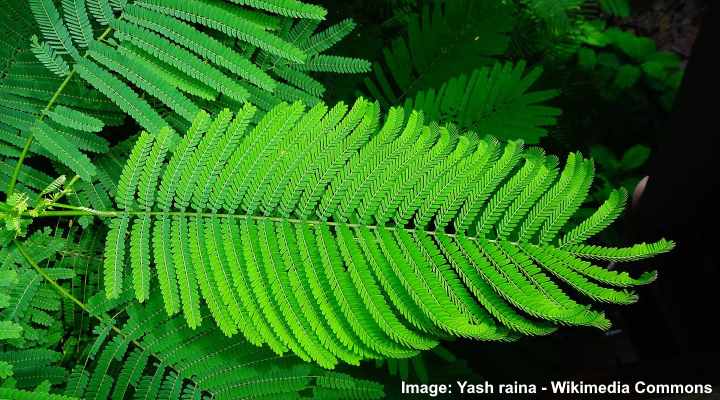
Royal poinciana leaves
Leaves growing on a royal poinciana tree are green, bi-pinnate, feathery, fern-like leaves made up of primary leaflets and secondary leaflets. Each leaf has 20 to 40 primary leaflets with between 50 and 70 small oval leaflets to a stem. The huge leaves measure 8” to 20” (20 – 50 cm) long.
The semi-evergreen foliage stays green throughout the year in tropical climates. However, the leaves turn brown in areas with cooler temperatures and drop in the fall or during especially dry seasons. In many ways, leaves on royal poinciana trees resemble mimosa trees or jacaranda trees.
Royal Poinciana Bark
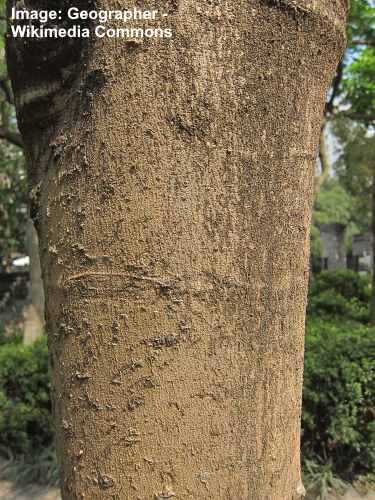
Royal poinciana bark
The bark on the royal poinciana tree trunk is light brown to grayish-brown and smooth, becoming slightly scaly as the tree ages. New stem growth on the tree is green, and the twigs and the thornless branches become a reddish-brown color. Due to its fast growth, royal poinciana branches are relatively brittle and prone to breakage.
Royal Poinciana Seed Pods (Fruit)
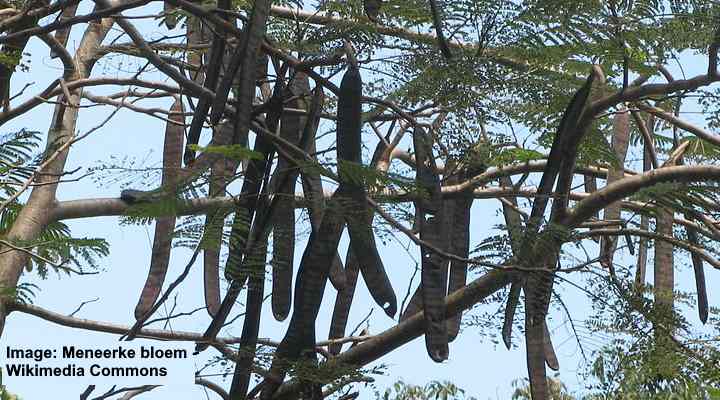
Royal poinciana seed pods
Seed pods grow abundantly on a royal poinciana tree after the showy blooms fade. The bean-like pods are dark brown and measure between 12” and 24” (30 – 60 cm) long, dangling in large clusters. The pendulous pods persist on the tree through winter and drop in spring.
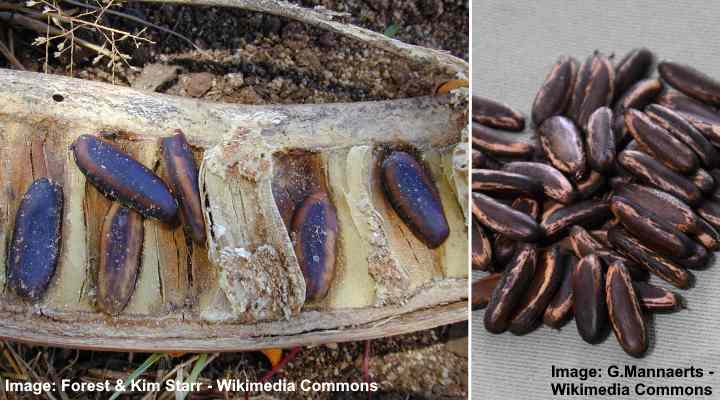
Royal poinciana seeds
When mature, royal poinciana seed pods release between 20 and 40 seeds. The challenge when growing a royal poinciana tree in your yard is clearing up the pods after they drop. There can be hundreds of long, brown, woody seed pods littering the garden landscape.
Royal Poinciana Identification
Royal poinciana is identified by its showy orange-red blossoms with five spreading petals, large feathery leaves, and a wide, spreading canopy. Due to its rounded crown and moderately dense fern-like leaves and long slender woody seed pods, the flamboyant flame tree is easy to spot in warm, southern landscapes.
Royal Poinciana in the Landscape
Royal poinciana has a rich visual appeal for landscapes. Its showy appearance and tolerance to heat make royal poinciana a popular tree in southern tropical gardens. The broad, spreading canopy means it’s an ideal shade tree in the summer. Additionally, the tree’s appealing shape and brilliant reddish-orange blossoms make it an attractive specimen tree.
Where to Plant Royal Poinciana
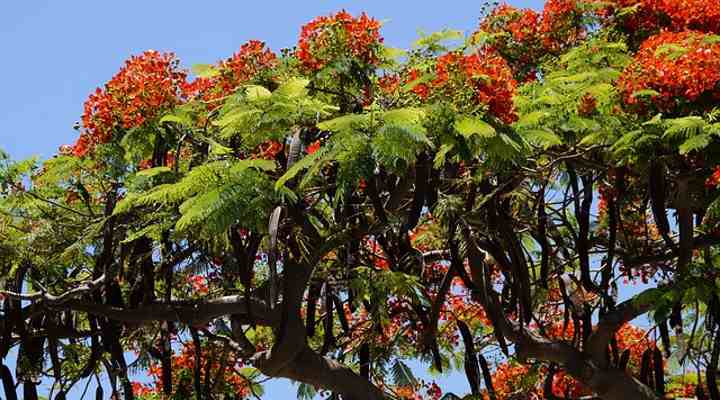
Royal poinciana tree grows best in full sun and well-drained soil
It’s vital to plant a royal poinciana tree in full sun and in a frost-free location. Getting at least six to eight hours of sunshine ensures plenty of blooms during late spring and early summer. In climates with mild winters, planting on the south side of a building is the best location.
Spacing is another consideration about the best location for planting a royal poinciana tree.
Ideally, it’s best to space the royal poinciana tree at least 20 ft. (6 m) from buildings and driveways. This prevents its shallow roots from causing damage. However, if you want to create an evergreen, flowering privacy screen, space the trees 12 to 15 ft. (3.6 – 4.5 m) apart.
Royal poinciana trees can be planted in various soil types, as long as the ground is well-drained. Although the tree will perform well in clay soil, sandy, loamy soil is best for fast growth. However, once established, the flame tree is tolerant of salty air and drought.
How to Plant Royal Poinciana
To plant a royal poinciana tree from a pot, dig a hole as deep as the root ball and three to four times wide. Set the tree in the spot and spread out the roots. Next, backfill the planting hole, pressing down as you go to eliminate air pockets.
After planting the flamboyant tree, water the root area thoroughly to hydrate the roots and remove remaining pockets of air.
To care for a newly-planted royal poinciana tree, water it deeply twice a week during the first season. This is vital to help the roots get established and build up drought tolerance. In hot weather, you may have to water the tree more frequently.
How to Grow Royal Poinciana From Seed
Growing royal poinciana trees from seed isn’t difficult. However, it can take at least four years for the tree to bloom, but sometimes even longer. Nevertheless, collecting the seeds and germinating them is relatively straightforward.
First, gather seeds from newly-fallen seed pods, ensuring the pods have opened naturally. Next, put the royal poinciana seeds in a jar of warm water and soak for 24 hours. Discard any that float. After that, nick or scratch each seed you plant to scarify it to allow water in and to speed up germination.
Planting royal poinciana seeds is easy. First, fill small seedling pots with a well-draining mixture of damp peat moss and perlite. Then press one seed into each pot about 1” (2.5 cm) deep. Lastly, put the pots in a warm, bright location protected from direct sunlight.
Keep the soil consistently moist over the next few weeks without becoming too soggy. Royal poinciana seeds take five to six weeks to germinate. When the seedlings are around 8” (20 cm) tall, you can transfer them to a larger pot to continue growing. Transfer to the ground in late March or April.
Growing Royal Poinciana in Container
A royal poinciana tree is easy to grow in a large container. For best results, it’s vital that the potting soil is a mix of peat moss, compost, and perlite — this ensures the soil retains moisture without becoming overly damp. Only water the potted flame tree when the top 1” (2.5 cm) of soil is dry.
Growing royal poinciana in a pot is ideal if you live in a temperate climate. You can keep the large potted tree in a conservatory or greenhouse during winter.
Potted royal poinciana trees can grow around 12 ft. (3.6 m) tall. However, if you want a smaller tree to grow, choose the dwarf poinciana tree cultivar Caesalpinia pulcherrima.
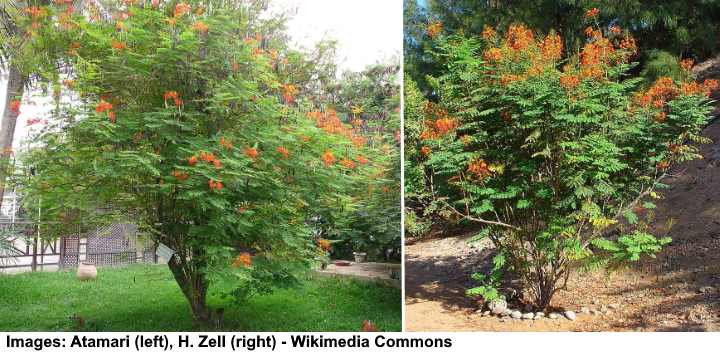
Dwarf poinciana (Caesalpinia pulcherrima) is a type of a shrub or multi stemmed tree that grow only to 10 ft. (3 m) tall
Royal Poinciana Care Guide
Once established, a royal poinciana tree doesn’t require much care. It is relatively resistant to drought and grows well if it gets enough sunshine. The main care considerations of a flame tree are regular pruning and clearing up fallen seed pods.
How to Water Royal Poinciana
Water a royal poinciana twice a week during spring and summer until the tree is established. During fall and winter, you can reduce watering to a minimum. It is crucial never to overwater a poinciana tree; otherwise, it could suffer from root rot and slow growth.
An established flamboyant tree rarely requires watering. A healthy tree is tolerant of drought, and you will find that the royal poinciana performs better in drier conditions. However, it’s crucial to water the ground enough to keep it slightly moist during dry, hot weather.
To keep the ground moist and reduce watering frequency, you can spread a 2” to 3” (5 – 7.5 cm) layer of mulch over the root area. Just make sure that there is a 3” (7.5 cm) gap around the tree’s trunk.
Royal Poinciana Fertilization
Newly planted royal poinciana trees under three years old need fertilizing two to three times a year. Use a balanced slow-release tree fertilizer with an NPK rating of 15-5-15. After three years, reduce fertilization to twice a year — in early spring and the start of summer.
After five years, an established royal poinciana doesn’t require regular fertilizing. Instead, all you need to do is work in some organic compost or rotted manure in spring to boost the soil’s nutrient level.
How to Prune Royal Poinciana
Regular pruning is vital to ensure a royal poinciana tree develops a strong branching structure. In addition, pruning a flamboyant tree removes branches prone to breaking, helps develop a central leader and allows space for walking under the canopy. Also, annual pruning is vital to chop off dead, diseased, or decaying branches.
The best time of year to prune a royal poinciana tree is in early spring, just before regrowth starts. Look for branches that appear sick or are rubbing together. Additionally, it’s a good idea to remove lower limbs from the tree to allow an 8 to 12 ft. (2.4 – 3.6 m) gap under the tree’s canopy.
Royal Poinciana Propagation
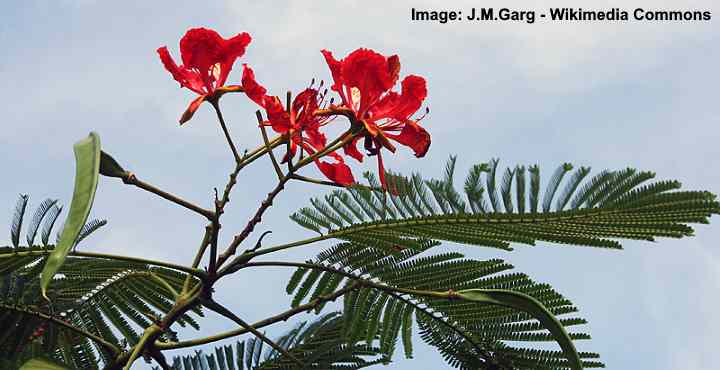
You can propagate royal poinciana from stem cuttings or seeds
Propagating a royal flamboyant flame tree from stem cuttings is relatively straightforward. Although propagating the tree from seed is the most common method, stem propagating will result in a tree that starts flowering earlier.
To grow a royal poinciana tree from a stem cutting, remove a 12” (30 cm) length of softwood that has several nodes on it. Then, strip off bark from the cut end and remove all the leaves apart from the last few at the tip. Next, dip the cut end in rooting hormone and place the cutting about 3” to 4” deep in a pot filled with well-drained potting soil.
It should take a few weeks for the cutting to take root. Keep the pot in a warm, bright location, and water the soil every so often to keep it moist. You can transfer the rooted poinciana tree to the ground in the fall or early spring in warm climates.
Pests Affecting Royal Poinciana Growth
Royal poinciana caterpillars (Melipotis acantoides) are the pests most commonly affecting the flamboyant tree. The striped black and brown caterpillar has a slender, worm-like body measuring 1.6” (40 mm) long. The destructive black bugs climb poinciana trees en masse to reach the foliage and gorge on it.
Royal poinciana caterpillars are nocturnal feeders that hide in dark places during the day. They typically emerge just before sunset to do their damage.
Controlling royal poinciana caterpillars can be tricky because there are so many of them. However, because they descend from the tree after feeding, laying burlap around the tree’s root can give them a place to hide during the day. Then you can remove the cloth and submerge it in hot soapy water during the day to kill off the black larvae.
Diseases Affecting Royal Poinciana Growth
Royal poinciana trees are relatively resistant to common diseases. Growing in full sun and tropical conditions mean that cold and humidity rarely affect the tree’s growth. However, it’s good to remember that frost can permanently damage a royal poinciana tree.
Overwatering is the most common reason a royal poinciana tree suffers damage. For example, soggy soil can lead to fungal root infections like Phellinus noxius. In addition, this brown root rot attacks the tree roots, cutting off nutrients and water to the tree.
The first signs of root rot in mature royal poinciana trees are yellow leaves due to a lack of chlorophyll and foliage becoming sparse. You may also notice brown patches around the base of the tree’s trunk.
Related articles:
- Beautiful Flowering Trees to Grow In Florida
- Types of Flowering Trees
- Mimosa Trees: Identification and Growing Guide
